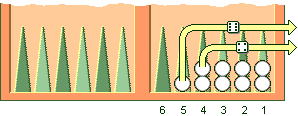
|
How to Play

|
|
|
Rules of Backgammon
|

|
|
Setup
|
|
Backgammon is a game for two players, played on a board consisting of twenty-four narrow triangles called points. The triangles alternate in color and are grouped into four quadrants of six triangles each. The quadrants are referred to as a player's home board and outer board, and the opponent's home board and outer board. The home and outer boards are separated from each other by a ridge down the center of the board called the bar.
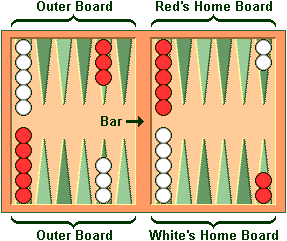 |
Figure 1.
A board with the checkers in their initial position.
An alternate arrangement is the reverse of the one shown here,
with the home board on the left and the outer board on the right.
|
The points are numbered for either player starting in that player's home
board.
The outermost point is the twenty-four point, which is also the opponent's
one point.
Each player has fifteen checkers of his own color.
The initial arrangement of checkers is:
two on each player's twenty-four point, five on each player's thirteen point,
three on each player's eight point, and five on each player's six point.
 Both players have their own pair of dice and a dice cup used for shaking.
A doubling cube, with the numerals 2, 4, 8, 16, 32, and 64 on its
faces, is used to keep track of the current stake of the game. Both players have their own pair of dice and a dice cup used for shaking.
A doubling cube, with the numerals 2, 4, 8, 16, 32, and 64 on its
faces, is used to keep track of the current stake of the game.
|
|

|
|
Object of the Game
|
The object of the game is move all your checkers into your own home board and then bear them off.
The first player to bear off all of their checkers wins the game.
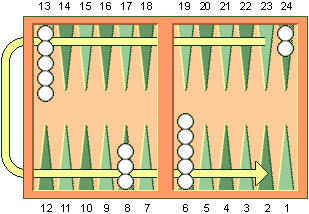 |
Figure 2.
Direction of movement of White's checkers.
Red's checkers move in the opposite direction.
|
|
|

|
|
Movement of the Checkers
|
|
To start the game, each player throws a single die.
This determines both the player to go first and the numbers to be played.
If equal numbers come up, then both players roll again until they roll
different numbers.
The player throwing the higher number now moves his checkers according to
the numbers showing on both dice.
After the first roll, the players throw two dice and alternate turns.
The roll of the dice indicates how many points, or pips,
the player is to move his checkers.
The checkers are always moved forward, to a lower-numbered point.
The following rules apply:
-
A checker may be moved only to an open point, one that is not occupied by two or more opposing checkers.
-
The numbers on the two dice constitute separate moves.
For example, if a player rolls 5 and 3, he may move one checker five
spaces to an open point and another checker three spaces to an open
point, or he may move the one checker a total of eight spaces to an
open point, but only if the intermediate point (either three or five
spaces from the starting point) is also open.
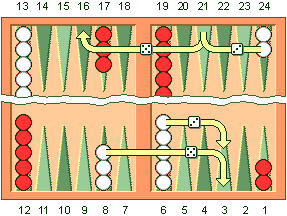 |
Figure 3.
Two ways that White can play a roll of
![[5]](rules/wdie5.gif) ![[3]](rules/wdie3.gif) . .
|
-
A player who rolls doubles plays the numbers shown on the dice twice.
A roll of 6 and 6 means that the player has four sixes to use, and he
may move any combination of checkers he feels appropriate to complete
this requirement.
-
A player must use both numbers of a roll if this is legally possible
(or all four numbers of a double).
When only one number can be played, the player must play that number.
Or if either number can be played but not both, the player must play
the larger one.
When neither number can be used, the player loses his turn.
In the case of doubles, when all four numbers cannot be played, the
player must play as many numbers as he can.
|
|

|
|
Hitting and Entering
|
|
A point occupied by a single checker of either color is called a blot.
If an opposing checker lands on a blot, the blot is hit and placed on
the bar.
Any time a player has one or more checkers on the bar, his first obligation
is to enter those checker(s) into the opposing home board.
A checker is entered by moving it to an open point corresponding to one of
the numbers on the rolled dice.
For example, if a player rolls 4 and 6, he may enter a checker
onto either the opponent's four point or six point, so long as the
prospective point is not occupied by two or more of the opponent's checkers.
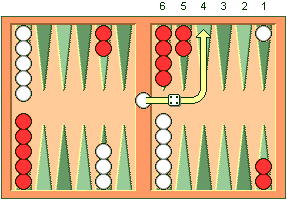 |
Figure 4.
If White rolls
![[6]](rules/wdie6.gif)
![[4]](rules/wdie4.gif) with a checker on the bar, he must enter the checker onto Red's four point
since Red's six point is not open.
with a checker on the bar, he must enter the checker onto Red's four point
since Red's six point is not open.
|
If neither of the points is open, the player loses his turn.
If a player is able to enter some but not all of his checkers, he must enter
as many as he can and then forfeit the remainder of his turn.
After the last of a player's checkers has been entered, any unused numbers
on the dice must be played, by moving either the checker that was entered
or a different checker.
|
|

|

|
|
Doubling
|
|
Backgammon is played for an agreed stake per point.
Each game starts at one point.
During the course of the game, a player who feels he has a sufficient
advantage may propose doubling the stakes.
He may do this only at the start of his own turn and before he has rolled
the dice.
A player who is offered a double may refuse, in which case he
concedes the game and pays one point.
Otherwise, he must accept the double and play on for the new higher
stakes.
A player who accepts a double becomes the owner of the cube and only
he may make the next double.
Subsequent doubles in the same game are called redoubles.
If a player refuses a redouble, he must pay the number of points that were
at stake prior to the redouble.
Otherwise, he becomes the new owner of the cube and the game continues
at twice the previous stakes.
There is no limit to the number of redoubles in a game.
|
|

|
|
Gammons and Backgammons
|
|
At the end of the game, if the losing player has borne off at least one
checker, he loses only the value showing on the doubling cube (one point,
if there have been no doubles).
However, if the loser has not borne off any of his checkers,
he is gammoned and loses twice the value of the doubling cube.
Or, worse, if the loser has not borne off any of his checkers and still has
a checker on the bar or in the winner's home board, he is backgammoned
and loses three times the value of the doubling cube.
|
|

|
|
Optional Rules
|
|
The following optional rules are in widespread use.
-
Automatic doubles.
If identical numbers are thrown on the first roll, the stakes are doubled.
The doubling cube is turned to 2 and remains in the middle.
Players usually agree to limit the number of automatic doubles to one per game.
-
Beavers.
When a player is doubled, he may immediately redouble (beaver) while
retaining possession of the cube.
The original doubler has the option of accepting or refusing as with a
normal double.
-
The Jacoby Rule.
Gammons and backgammons count only as a single game if neither player has
offered a double during the course of the game.
This rule speeds up play by eliminating situations where a player avoids
doubling so he can play on for a gammon.
|
|

|
|
Irregularities
|
-
The dice must be rolled together and land flat on the surface of the
right-hand section of the board.
The player must reroll both dice if a die lands outside the right-hand
board, or lands on a checker, or does not land flat.
-
A turn is completed when the player picks up his dice.
If the play is incomplete or otherwise illegal, the opponent has the option
of accepting the play as made or of requiring the player to make a legal play.
A play is deemed to have been accepted as made when the opponent rolls his
dice or offers a double to start his own turn.
-
If a player rolls before his opponent has completed his turn by picking up
the dice, the player's roll is voided.
This rule is generally waived any time a play is forced or when there is no
further contact between the opposing forces.
|
|
Common Questions
Other Games
Forms of Competition

Return to:
Backgammon Galore
|
|
|
|


 Both players have their own pair of dice and a dice cup used for shaking.
A
Both players have their own pair of dice and a dice cup used for shaking.
A 



